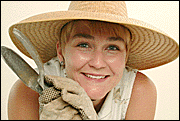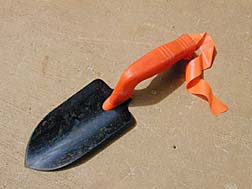Advertisement - Click to support our sponsors.


Dig This
![]()
Friday, April 28, 2000

By Kathryn Bender, Star-Bulletin
Adaptations like raised planting beds and long-handled
watering wands make it easier for Sesine Filipo, 13, to work
in the garden at Shriners Hospital.
GARDENING is not for wimps. Soft tissue injuries like strained backs are common among gardeners. And tendinitis and other repetitive stress injuries can be exacerbated by gardening, according to Dr. Lance Yokochi, a staff physician in the Occupational Medicine department at Straub. Stretch your
gardening pleasureWhile Yokochi treats mostly work-related injuries, the problems he sees among those in farming and landscaping jobs are applicable to the home gardener, he said.
But good physical habits and smart tools can help the gardener avoid injury and continue to garden in the face of physical barriers.
"The key is proper posture or body mechanics," said Yokochi. For example, don't bend over to pick things up. "The legs are stronger than the back," he said, use them.
Ginny Meade, a garden consultant and founder of Growing Well: Horticulture for Health and Wellbeing, recommends regular stretching for the home gardener to strengthen the back, legs, arms and hands.

Both Yokochi and Meade cautioned against rushing and heavy lifting."Don't do everything you think you can do," said Meade. "Think about each move that your body is making at the time."
The gardener's choice of tools also can help. Using a dolly or cart for big pots and other heavy items, for example, reduces the likelihood of back injury. Jennie Peterson, environmental educator at Hawaii Nature Center, raved about the garden cart she got from http://www.gardencart.com. "You can pull a ton of weight on it with practically your little finger," she said.
And tools with soft, large diameter grips are more ergonomically sound, said Yokochi.
But that doesn't necessarily mean you have to buy new tools. Meade said tubes of foam pipe insulation can be added to tool handles to make the grip softer and larger.
"You have to look at things with an eye to what you can adapt it to," said Meade. "Adapt your tools to what works for you."
For example, she uses a length of PVC pipe with a slanted cut on one end to shoot seeds into the ground while sitting.
"I have arthritis. It's just minimal with me, but I know it's coming on," said Meade. "All of these things are considerations for what I think would make it easier."
Long-handled tools have the advantage of minimizing reaching and bending, according to Meade. "Most of us don't pay too much attention to our back, so when you're reaching you're liable to not do it correctly," she said. She uses a long-handled grabber with suction cups for picking up pots and a long-handled water spreader.
Ergonomically designed garden tools are not widely available locally, said Meade, although she has had some luck at Home Depot and Costco, as well as with companies that serve the elderly and disabled like CRNewton (the long-handled grabber); Hawaii Assistive Technology Training and Service, and PacMed (tools with soft rubber grips).
But there are a multitude of smart tools available online, according to Meade.
Another way to minimize gardening's wear and tear on the body is by building raised beds rather than planting directly in the ground.
Meade has helped Shriners Hospital redesign its garden to make it more accessible to patients. Part of that effort involved constructing raised beds with cinder block walls. The beds were built right over bare ground, reinforced at a few points with rebar and cement, and filled in with a soil mixture of dirt, compost, manure and cinders.
"The nice thing about any kind of raised bed, even a foot, is you now have control over the soil," said Meade. Raised beds require less weeding and yield loose, easy to work soil. The cinder block puka that were not filled with cement also make good planting holes for plants that can grow down to cover the walls, said Meade.
Gardening beds designed to be worked from a seated position should be 24 inches high. she said. Raised beds also can be designed to be worked while standing. "The ideal is to get it at your hand level," said Meade. Beds should be no more than 2 feet deep if accessible only from the front, 4 feet if accessible from front and back.
The point of all this is to better enjoy time spent in the garden. "Gardening is really the most therapeutic tool in the world," said Meade.
The following websites were recommended by Ginny Meade of Growing Well: Horticulture for Health and Wellbeing or Jennie Peterson of the Hawaii Nature Center for their selection of smart garden tools: GARDEN TOOLS ONLINE
www.gardencart.com, 800-335-2278
www.leevalley.com, 800-267-8735
www.earthmade.com, 800-843-1819
www.dynamic-living.com, 800-940-0605
www.charleysgreenhouse.com, 800-322-4707
www.amleonard.com, 800-543-8955
Gardening Calendar in Do It Electric!
Stephanie Kendrick's gardening column runs Fridays in Today.
You can write her at the Star-Bulletin, P.O. Box 3080, Honolulu 96802
or email skendrick@starbulletin.com